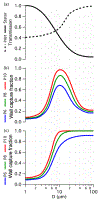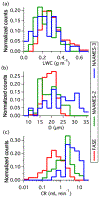Development and characterization of a high-efficiency, aircraft-based axial cyclone cloud water collector
- PMID: 33868504
- PMCID: PMC8051007
- DOI: 10.5194/amt-11-5025-2018
Development and characterization of a high-efficiency, aircraft-based axial cyclone cloud water collector
Abstract
A new aircraft-mounted probe for collecting samples of cloud water has been designed, fabricated, and extensively tested. Following previous designs, the probe uses inertial separation to remove cloud droplets from the airstream, which are subsequently collected and stored for offline analysis. We report details of the design, operation, and modelled and measured probe performance. Computational fluid dynamics (CFD) was used to understand the flow patterns around the complex interior geometrical features that were optimized to ensure efficient droplet capture. CFD simulations coupled with particle tracking and multiphase surface transport modelling provide detailed estimates of the probe performance across the entire range of flight operating conditions and sampling scenarios. Physical operation of the probe was tested on a Lockheed C-130 Hercules (fuselage mounted) and de Havilland Twin Otter (wing pylon mounted) during three airborne field campaigns. During C-130 flights on the final field campaign, the probe reflected the most developed version of the design and a median cloud water collection rate of 4.5 mL min-1 was achieved. This allowed samples to be collected over 1-2 min under optimal cloud conditions. Flights on the Twin Otter featured an inter-comparison of the new probe with a slotted-rod collector, which has an extensive airborne campaign legacy. Comparison of trace species concentrations showed good agreement between collection techniques, with absolute concentrations of most major ions agreeing within 30 %, over a range of several orders of magnitude.
Conflict of interest statement
Competing interests. The authors declare that they have no conflict of interest.
Figures












References
-
- Barth MC, Cantrell CA, Brune WH, Rutledge SA, Crawford JH, Huntrieser H, Carey LD, MacGorman D, Weisman M, Pickering KE, Bruning E, Anderson B, Apel E, Biggerstaff M, Campos T, Campuzano-Jost P, Cohen R, Crounse J, Day DA, Diskin G, Flocke F, Fried A, Garland C, Heikes B, Honomichl S, Hornbrook R, Gregory Huey L, Jimenez JL, Lang T, Lichtenstern M, Mikoviny T, Nault B, O’Sullivan D, Pan LL, Peischl J, Pollack I , Richter D, Riemer D, Ryerson T, Schlager H, St. Clair J , Walega J, Weibring P, Weinheimer A, Wennberg P, Wisthaler A, Wooldridge PJ, and Ziegler C: The deep convective clouds and chemistry (DC3) field campaign, B. Am. Meteorol. Soc, 96, 1281–1310, 10.1175/BAMS-D-13-00290.1, 2015. - DOI
-
- Bator A and Collett JL: Cloud chemistry varies with drop size, J. Geophys. Res.-Atmos, 102, 28071–28078, 10.1029/97JD02306, 1997. - DOI
-
- Benedict KB, Lee T, and Collett JL: Cloud water composition over the southeastern Pacific Ocean during the VOCALS regional experiment, Atmos. Environ, 46, 104–114, 10.1016/j.atmosenv.2011.10.029, 2012. - DOI
-
- Bernardin JD, Mudawar I, Walsh CB, and Franses EI: Contact angle temperature dependence for water droplets on practical aluminum surfaces, Int. J. Heat Mass Tran, 40, 1017–1033, 10.1016/0017-9310(96)00184-6, 1997. - DOI
Grants and funding
LinkOut - more resources
Full Text Sources
Miscellaneous
